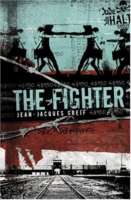
The Fighter
Written by Jean-Jacques Greif
Bloomsbury, 1998, 206 pp, ISBN 13: 978-1-58234-891-9
The earth rotates around the sun, undisturbed by the terrible pain human beings inflict upon each other (p. 149).
From Warsaw, Poland as a child, to Paris, France as a young adult, and then to a series of work camps under the Nazi Regime, Moshe Wisniak is a fighter. He fights to establish his right to exist and then fights to stay alive, because as a Jew in the first half of the 20th century, Moshe is not respected, not wanted, not considered fully human. As a young child in Warsaw, Moshe had to fight because of the harsh sentiments the Poles harbored against Jews and because he had no father to protect him. When his family moves to Paris in an attempt to create a better life without the racism they experienced in Poland, Moshe changes his name like the rest of the members of his family in the hopes of fitting in. As Maurice, he becomes a recreational boxer and attempts to make a life for himself and eventually his wife and small child. He soon gives up boxing to concentrate more on the good life he is beginning to lead as a family man. The Nazi insurgence into Paris destroys this hope as Maurice is forced to participate in a work camp outside of the city, where brutality is the norm. As the war progresses, the workers in the camp are moved to Auschwitz/Birkenau (the Auschwitz complex consisted of three main camps, Auschwitz, Birkenau, and Monowitz) where Maurice realizes that he is only attempting to survive, not live through the war. Working a number of jobs to stay alive, Maurice begins to wonder if he can ever return to the person he was becoming in Paris.
Told as a first person account, this piece of fiction holds the reader hostage to the cruelty and horror of the Jewish Holocaust. As Maurice’s job responsibilities change, the reader is presented with the enormity of the Holocaust and the myriad ways the Nazis devised to achieve the genocide of Jews in Europe. The horror, however, is balanced by the humor and the resilience of the Moshe/Maurice character. This high school text reads quickly, chapters are short, and the prose well written and accessible to young adult readers. The novel is more than storytelling, the reader is drawn into the drama and just as expected, pulling for “the fighter” that is the central metaphor for the text. Readers will also find that they not only root for the fighter, but begin to question the reasons for why such atrocities and prejudice occurred and still exist in the world. Because the character of Maurice is well-read and aware of the politics of the era, the reader is also educated on aspects of the Holocaust often not addressed in schools. Additionally, Maurice is a truly likable character, and students interested in the Holocaust will find the book staying with them long after the last page is turned.
Based on incidents from Maurice Garbarz’s text, Un Survivant (1984), The Fighter is a blending of the author’s memories and Maurice’s experiences as a Holocaust survivor written for high school students. It broadens the extensive events and experiences well documented through other literature and research on the Holocaust. Many of the incidents, both everyday life in Paris prior to the war as well as the atrocities experienced by those in the camps, are part of either the author’s life in Paris or Maurice Garbarz’s existence in the Nazi camps. Complementary reading to this text would include The Book on Everything (Kuijer, 2004), Night (Wiesel, 2006), The Cage (Sender, 1997), and Anne Frank: The Diary of a Young Girl (Frank, 1993) Tamar: A Novel of Espionage, Passion, and Betrayal (Peet, 2007) is another fine piece of adolescent literature that addresses the French Resistance. Adding to the variety of perspectives on those most affected by the Holocaust, The Fighter brings another family account to the books available to young adults.
Holly Johnson, University of Cincinnati, Cincinnati, OH
WOW Review, Volume I, Issue 1 by Worlds of Words is licensed under a Creative Commons Attribution-NonCommercial-ShareAlike 4.0 International License. Based on work at https://wowlit.org/on-line-publications/review/i-1/
